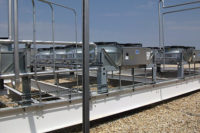Refrigerants are all the talk these days in refrigeration. That was evident at the 66th International Air-Conditioning, Heating, and Refrigerating Exposition (AHR) in New York City. Much of the water-cooler banter centered on newer refrigerants and new equipment.
The late January expo occurred in the midst of a comment period (extending to March 10) regarding the U.S. Environmental Protection Agency’s (EPA) final phase out proposals concerning production and importation of hydrochlorofluorocarbon (HCFC)-22.
On the show floor, some exhibitors were hosting seminars and technical talks on hydrofluorocarbon (HFC) refrigerants that have low global warming potential (GWP). And others were continuing to show how so-called natural refrigerants like CO2 and hydrocarbons (HCs) could work in stationary refrigeration equipment.
Phase Out
As part of the R-22 phase out schedule, a number of stakeholders asked for a hearing with the EPA, which occurred Jan. 23 in Washington, D.C., — the last day of the expo in New York, meaning some AHR attendees exited the expo early to be in Washington.
With the industry sitting on an allowable allocation of 51 million pounds of new R-22 in 2014, much of the debate centered on how much should be produced after that date. The EPA’s Option 1 “preferred linear reduction” allows 30 million pounds in 2015, then reduces the total by 6 million pounds each year until the spigot is closed completely on Jan. 1, 2020. But the hearing, as well as scuttlebutt within the industry, is indicating that many stakeholders want the EPA’s Option 2 of a “linear reduction with accelerated phase-out.” That starts with a 27 million pound allocation in 2015, followed by 9 million pound reductions annually until there is no more new R-22, effective Jan. 1, 2018.
One aspect urging critics is that the industry is already sitting on close to 100 million pounds of R-22 in inventory, which many claim is restricting the reclamation of R-22 and conversion of existing R-22 equipment to non-HCFC refrigerants. Virtually no new equipment is being installed using R-22, meaning the current inventory and any new R-22 that might be produced would only be for aftermarket applications.
HFCs
With HCFCs on a short leash of four to six years before total phase out, the long-term future of HFCs appears brighter, although talks continue on a global basis for some sort of phase down timeline based on GWP. Also, domestically, the possibility exists that the EPA might take some higher GWP HFCs off its Significant New Alternatives Policy (SNAP) list, eliminating them from consideration in new applications.
That two-fold factor is causing the industry to pay a lot of attention to low-GWP refrigerants. Emerson Climate Technologies hosted a webinar at the AHR Expo, titled, “A Conversation on Refrigerants,” which was an installment in Emerson’s ongoing “Making Sense” webinar series. It consisted of a panel discussion hosted by Rajan Rajendran, vice president of engineering services and sustainability for Emerson. He serves on Air-Conditioning, Heating, and Refrigeration Institute’s (AHRI) Low-GWP Alternative Refrigerants Evaluation Program Task Force committee and the working groups for A2L Refrigerants committee at Underwriters Laboratories (UL).
Guest panelists consisted of Barbara Minor, senior technical fellow at DuPont Fluoroproducts; Mark Spatz, global refrigerant technology leader at Honeywell’s Fluorine Products; and Brett Van Horn, global project leader, research and development, at Arkema Inc. They reviewed new, non-HCFC refrigerants being developed for retrofit and new applications, ways to minimize refrigerant transition costs in an uncertain regulatory climate, and ways to evaluate lower-GWP refrigerants, both synthetic and natural.
Beyond HFCs
A few hours later, at the booth of Parker Hannifin’s Sporlan Division, hydrocarbons (HCs) and other natural refrigerants were being reviewed in a PowerPoint presentation by Bill Wilken, national account manager for the Sporlan Division.
The thrust of his talk was the increasing number of naturals coming into the HVACR industry and the equipment being developed to work with them. He urged contractors and engineers to continue to be aware of the new refrigerants and eventually be prepared to work with them. In response to a question, he said more training is needed within the industry and consideration should be given to certification programs in regard to naturals.
On Site
During a press breakfast, Jeff Staub, application engineering manager for Danfoss, focused on both low-GWP HFCs as well as the “naturals.” He said, “Choice of refrigerant depends on applications, regulations, regional variations, and educational level in the service sector. There is no single refrigerant that fits all applications.”
Mike Ellinger, who is in charge of global maintenance and refrigeration for Whole Foods Market, reported on the opening a month before of a 55,000-square-foot store at Third Avenue and Third Street in Brooklyn, just a few miles from the expo. The store features a CO2 transcritical refrigeration system.
“This is the first synthetic refrigerant-free store in the USA,” he said.
He did pick up on some of the points raised by Staub in noting that the Brooklyn store required “navigating permit requirements and a lack of language in codes,” which lead to “unexpected costs due to regulatory modifications.” And while there were “higher initial system costs compared to DX systems,” he said it would take at least six months of data to compare performance of the transcritical CO2 store to one using a conventional DX system.
Publication date: 3/3/2014
Want more HVAC industry news and information? Join The NEWS on Facebook, Twitter, and LinkedIn today!









